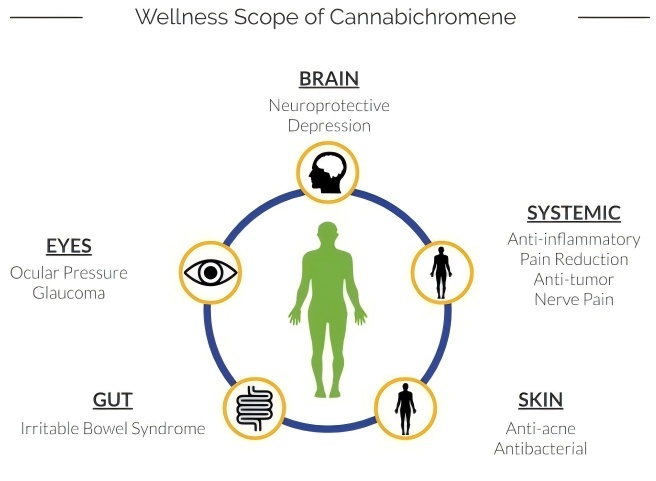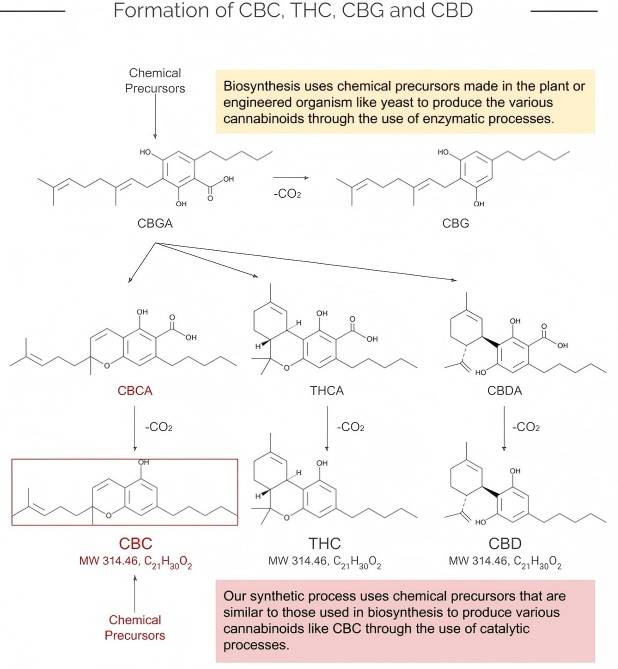Cannabichromene (CBC) (CAS 20675-51-8) is a non-psychoactive cannabinoid recognized for its potential synergistic role in the "entourage effect" and its distinct pharmacological profile. Unlike THC, it does not bind strongly to CB1 receptors but interacts with other targets such as TRPV and serotonin receptors, contributing to its studied anti-inflammatory, antimicrobial, and neurogenesis-promoting properties. Though typically found in low concentrations in cannabis cultivars, its emerging therapeutic potential makes it a compound of growing interest in neurological and inflammatory disorder research.
Name :
Cannabichromene (CBC)CAS No. :
20675-51-8MF :
C₂₁H₃₀O₂MW :
314.46Purity :
99%Appearance :
Oil or crystalline solid (depending on purity)Storage Condition :
-20°C in airtight containers, protected from lightChemical Properties
Molecular Formula: C₂₁H₃₀O₂
Molecular Weight: 314.46 g/mol
CAS Number: 20675-51-8
Appearance: Oil or crystalline solid (depending on purity)
Melting Point: ~145°C
Boiling Point: ~394°C (estimated)
Solubility: Soluble in chloroform, dichloromethane, ethanol, DMSO, and acetone; sparingly soluble in water
LogP: 8.56 (highly lipophilic)
Biological Activities
Antimicrobial: Exhibits strong activity against antibiotic-resistant bacteria (e.g., MRSA)
Anti-inflammatory: Modulates TRPV1 and TRPA1 receptors, reducing pain perception and inflammation
Neuroprotective: Promotes neurogenesis and protects against neurodegenerative diseases (e.g., Alzheimer’s) in preclinical studies
Antidepressant-like Effects: Enhances serotonin and dopamine signaling in rodents
.
Applications
Pharmaceutical Research: Investigated for pain management, neurodegenerative disorders, and antimicrobial therapies
Cannabinoid Products: Used in "full-spectrum" CBD formulations due to synergistic effects with other cannabinoids (entourage effect)
Analytical Standards: Certified reference material (CRM) for HPLC/MS testing in cannabis potency analysis

Synthesis and Production
Synthesis Pathway: Derived from cannabigerolic acid (CBGA) via enzymatic cyclization.

Shipment Guidelines

Labeling: Include hazard symbols CAS number, and "Keep Away from Heat/Incompatible Substances" warnings.

Air Freight: Preferred for urgent shipments; ensure packages meet IATA Dangerous Goods Regulations (DGR) for organic peroxides.
Shipping Modes:
Expedited: 3–5 business days (e.g., DHL Express) for time-sensitive research projects.
Standard: 7–14 days via sea freight, cost-effective for bulk orders.

Storage Conditions:
Pre-Shipment: Store at 2–8°C if light-sensitive; avoid freezing to prevent crystallization.
In Transit: Maintain ambient temperature (15–25°C) with humidity <60%. Use data loggers for real-time monitoring.
Risk Mitigation: Include desiccants and oxygen absorbers in packaging. Avoid prolonged exposure to sunlight or electromagnetic fields.
-
FAQ
Q: What is Cannabichromene (CBC)?
A: Definition: CBC is a non-intoxicating phytocannabinoid derived from the cannabis plant, chemically synthesized from cannabigerolic acid (CBGA). Its molecular formula is C₂₁H₃₀O₂, and it shares structural similarities with THC and CBD but binds to distinct receptors
Q: Is CBC safe?
A: Side Effects: Mild (dry mouth, fatigue, dizziness) at low doses; rare gastrointestinal issues
Toxicity: No significant acute toxicity in rodents; safe up to 20 mg/kg in mice
Drug Interactions: May inhibit CYP450 enzymes, affecting drug metabolism (e.g., anticoagulants)
Q: CBC vs. Cannabicyclol (CBL)
A: CBC decarboxylates into CBL (a minor cannabinoid), but CBL lacks CBC’s therapeutic activity.
Q: Future Research Directions?
A: Chirality: Studying (-)-CBC’s superior CB2 receptor activation over (+)-CBC
.Cancer Therapy: Combining CBC with temozolomide to enhance tumor suppression .
Skin Health: Developing CBC-based acne treatments .
Leave A Message
Scan to Wechat/Whatsapp :

